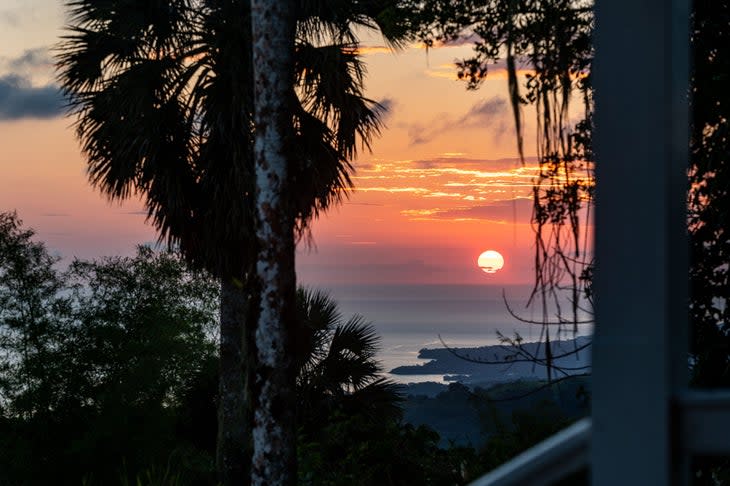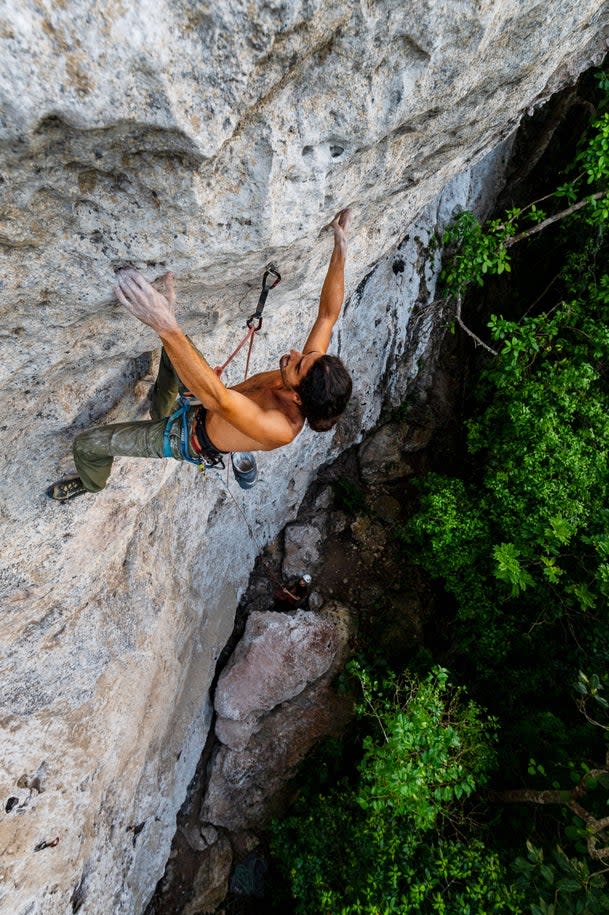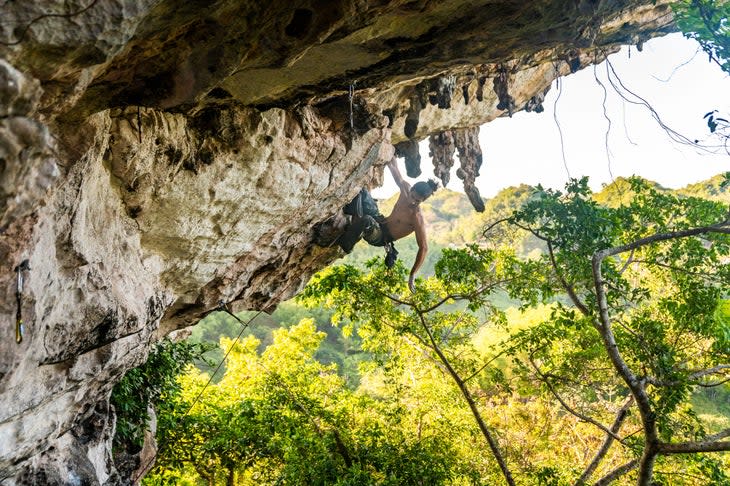Jamaica Has Incredible Limestone Crags
This article originally appeared on Climbing
Sweat poured off Juan Luis Toribio's brow and down his arms into his chalk-caked palms as he labored through an overhanging cave in Discovery Bay, on the northern coast of Jamaica. He'd stop periodically to thread a sling through two pockets or drape one over a jug, carefully shifting his weight from the rock to the fabric so he could drill a hole and install an expansion bolt for protection.
Stifling, stagnant air and rudimentary gear didn't deter Toribio from establishing what would become Jamaica's first 5.12--and one of the first routes on the island. Eventually, the route would be extended and named Chilam Yahman (5.13a) after Spain's famed route, Chilam Balam. A few hundred yards behind the cave, the clear blue water that draws most tourists to Jamaica's northern coast crashed against the rocky coastline, serving as the perfect backdrop for the birth of climbing in Jamaica.

When Toribio left his home in Spain to start a job as a Spanish lecturer in January 2021, there were only four bolted routes on the island, established by another Spanish climber, Daniel Oury, who also made his way there for a work opportunity in 2017. In addition to murmurs of a few people scrambling around the island over the years, there had been some deep water solo ascents completed in 2006 by Josh Lowell, Brett Lowell, and Chris Sharma while in Negril for a bachelor party. But while the group of climbers did see potential, they never fulfilled the idea of heading back for further exploration.
With only one other climber around--Bogdan Simandan, a Kingston-based Romanian climber who also helped with early route development--and very little interest among locals, Oury lost steam after bolting the first few routes at a limestone cliff in Discovery Bay, an hour east of the popular tourist destination Montego Bay.
"Equipping [routes] is a very nice job but it isn't rewarding if there is no one around who is interested in climbing," Oury said. "The routes I equipped were designed for people who wanted to get into the sport. And people really liked it, but they would try a couple of times and not continue. So I started to focus on canyoning instead."

It wasn't long after his arrival that Toribio was connected with Oury, who quickly took him under his wing, teaching him how to establish new routes on virgin rock. Within weeks, the two quadrupled the number of climbs on the island. After Oury moved back to Spain in June, Toribio continued bolting, expanding the number of available climbs to over 100 on four major limestone cliffs--Tangle River, Discovery Bay, Cane River Falls, and Coral Spring--and a few smaller crags across the island.
"Initially, the reason I started bolting routes in Jamaica was kind of selfish--I wanted somewhere to climb," Toribio recounted. "But I realized quite fast it wasn't enough to just bolt routes. What I wanted to do was to create a community of climbers to have people to climb with. I thought it was pretty pointless if it’s just a couple of foreigners climbing over here."
He began an Instagram page (@Jamrockclimbing) as well as a WhatsApp chat group, which currently has nearly 80 participants, in an attempt to increase visibility of the sport and encourage locals to engage. Gear donations began trickling in, and people started expressing interest in trying the sport for the first time. As local Jamaicans reached out, Toribio would teach them how to safely use belay devices and tie knots and encourage them as they embarked on their first climbs.
But getting locals interested in the sport proved to have its difficulties.
"I think there is a cultural aspect there," said Michelle Bloomfield, a Kingston native who was living near the north coast when she found out about Jamaica's climbing through social media and made it a part of her weekly routine for half a year. "We haven’t found those hungry people who did it one time and said 'I need this'. And the ones who have, have a lot of the socio-economic issues that come with spending days and days climbing. You have to think about things like transportation, and a lot of us are finding it hard to integrate [climbing] into our lives."

According to Bloomfield, her and most other Jamaicans who are familiar with climbing have only encountered it through foreign media. Add to the unfamiliarity the fact that the sport is relatively inaccessible, and the struggles that come with creating a climbing community in Jamaica almost seem inevitable.
"A lot of people won't even go to our national park," she chuckled. "It's too far. And up in the bush with the cold? No way."
Even Bloomfield, who has been climbing two dozen times and spoke of the sport with immense excitement and optimism, has since moved back to Kingston, nearly three hours from where much of the climbing takes place (aside from Cane River Falls, which is just outside of Kingston), and has struggled to get out.
Toribio has also been met with a lot of reluctance from a cultural standpoint, with many Jamaicans writing climbing off as "a white man's sport," preferring instead to use their free time to do more popular things like go to the movies or a club. Others yet have been untrusting of a foreigner offering them something for free, having become accustomed to a capitalist society where most leisure activities are catered to a wealthy minority.
Skepticism of locals aside, it comes as a surprise that Jamaica, which is highly visited for its beaches and resorts (some of which sit in the shadows of untouched limestone cliffs), hasn't garnered interest of foreign climbers sooner.
"I think the reason it hasn’t become Cuba or some other destination like that is because it’s a really expensive country," said Toribio. "Climbers tend to want to go somewhere cheap where they can stay for a long time and have cheap accommodations. And above all, I think most tourists come for a resort experience."
He continued, explaining that many of the cliffs are hidden beneath lush undergrowth in the middle of the country, and adding that many governments discourage tourists from exploring Jamaica, instilling a fear of danger and crime.
"It's unfair because it’s not as dangerous as they make it seem. There’s actually a lot of backlash from the army and police if anything happens to a tourist. But most tourists are scared to drive around and explore the countryside."
Despite the slow start, Toribio is determined to continue his efforts, now looking into the development of a free climbing gym near the city of Kingston, with the hope that it can serve as an accessible transition into the sport. While there are a number of locations being considered, there is hope there will be support from the local government, although there's still much uncertainty surrounding that. Bloomfield agrees that a gym might be just what the country needs, serving as a medium that locals can use to ease themselves into what can be an unfamiliar and intimidating sport.
"I don’t know what the climbing scene is going to look like in Jamaica," said Bloomfield. "Is it going to be a memory? I think it does have its place, but for now, climbing [in Jamaica] is still in its infant stages."
If the time and patience it took for Oury and Toribio to establish the first routes on the island is any indicator, building a Jamaican climbing community will be a slow but worthy endeavor. And if climbing in Jamaica does become nothing more than a distant memory, for Toribio, Bloomfield, and anyone else who was a part of it in any way, it will be a memory worth having.
Also Read:
For exclusive access to all of our fitness, gear, adventure, and travel stories, plus discounts on trips, events, and gear, sign up for Outside+ today.

